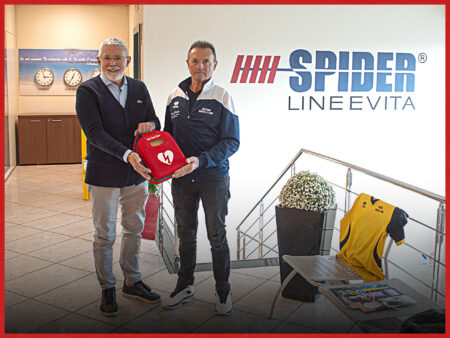The manufacturing industry has been the beating heart of the Italian economy for centuries, but today it is facing unprecedented challenges. On the one hand there is the need to preserve centuries-old knowledge and traditions that have made Made in Italy great in the world, on the other the need to innovate, to exploit new technologies to make processes more efficient, products more competitive and workplaces safer. Safety at work is a crucial issue for companies: this is why Inail has analyzed how companies are investing in prevention and training, with encouraging results but also room for improvement. Let’s see the data and stories of some Italian excellences.
If you want to keep up with the times, you need to take advantage of new technologies. The Italian manufacturing industry knows this well and in recent years has invested heavily in innovation.
The Italian manufacturing industry has a long tradition, but continues to look to the future. Taking advantage of new technologies, Italian companies confirm their global leaders in key sectors such as mechanics, fashion and design. The combination of artisan know-how and technological innovation is the key to success.
INAIL (National Institute for Insurance against Accidents at Work) has recently published new data on accidents at work in the Italian manufacturing sector for the year 2023. These figures highlight the importance of continuing to invest in occupational safety and improving workers’ conditions.
INAIL data
INAIL has published new data regarding accidents at work in the Italian manufacturing sector in 2021, which employed 3.7 million people. The increase in accident reports affected almost all activities, except the production of pharmaceutical products and the tobacco industry. The most common injuries were in the manufacture of metal products and in the manufacture of machinery. In 2021, 71.4% of reported pathologies concerned male staff. The age of injured people is increasing, especially among female workers. INAIL is also committed to identifying solutions and prevention measures to reduce the risk levels related to hardwood dust, classified as carcinogenic. Companies that invest in prevention can benefit from financing and discounts on insurance premiums.
Among the most common injuries in the manufacturing sector, we find those related to manual handling of loads, falls from height, accidents with machinery and exposure to dangerous substances. These accidents can cause temporary or permanent injuries and, in some cases, can be fatal. Some risk factors that contribute to accidents at work include lack of proper training, lack of maintenance of plant and equipment, lack of safety procedures and insufficient supervision by managers.
Most common injuries
Risk factors
Training and the culture of prevention are fundamental levers to improve safety at work. As a company, investing in employee training is crucial to creating a safe and healthy work environment.
Safety training courses should be regular and mandatory for all employees. Not only new hires, but also experienced staff need regular updates on security procedures, emerging risks and best practices. Training should be practical as well as theoretical, with exercises and simulations to prepare employees to face real situations.
Safety at work is not only the responsibility of the employer, but of everyone. Employees should be encouraged to report dangerous conditions or behavior and propose improvements. Security procedures should be clear, easy to understand and apply. Employees who follow the rules and take care of colleagues should be recognized and rewarded.
To promote safety, you need to develop a positive culture throughout your company. Management must demonstrate its commitment to safety, praise employees who respect safety, and encourage collaboration between departments. Employees need to feel comfortable raising concerns, asking questions, and suggesting ways to improve safety. A strong and widespread culture of prevention is the foundation of a truly safe work environment.
Training, shared responsibility and a positive culture of prevention are the pillars of an effective occupational safety program.
A healthy and safe work environment is critical to employee well-being and company productivity. As an employer, you have a duty to ensure the safety of your employees, but it can also be an opportunity to improve efficiency and attract new talent.
Make sure that the working environment has sufficient space, good ventilation, adequate lighting and comfortable temperature for employees. These basic conditions contribute to the physical and mental well-being of workers.
Provide all the necessary equipment, personal protective equipment (PPE) and training so employees can do their jobs safely. This includes:
Perform periodic risk assessments to identify potential hazards. Establish monitoring procedures to control working conditions and make changes where necessary. Involve employees in the process to get their feedback. Workplace safety is a shared responsibility, so it also encourages employees to report any risks or issues.
A sic work environment
Many companies are committed to ensuring the safety of their employees, but it is normal for doubts and questions to arise. Here are some of the most common questions about occupational safety and answers to clarify them.
The employer is responsible for:
Yes, in the event of serious and immediate danger, the worker has the right to leave the workplace. However, you must notify your employer immediately. If the working conditions present risks to health and safety, the worker may exercise the right of refusal after informing the employer.
Risk assessment is the process of identifying and analysing hazards in the working environment that can cause occupational accidents or diseases. The employer is required by law to periodically carry out the risk assessment in order to take the necessary prevention and protection measures.
PPE, or personal protective equipment, is equipment designed to be worn to protect the worker against risks which cannot be avoided or sufficiently reduced by technical preventive measures, collective means of protection, measures, methods or procedures for the reorganization of work.
Hi how are you? Are you an entrepreneur or an industrial manager? Then this article is for you. The manufacturing industry has been the beating heart of the Italian economy for centuries, but today it is facing unprecedented challenges. On the one hand there is the need to preserve centuries-old knowledge and traditions that have made Made in Italy great in the world, on the other the need to innovate, to exploit new technologies to make processes more efficient, products more competitive and workplaces safer. Safety at work is a crucial issue for companies: this is why Inail has analyzed how companies are investing in prevention and training, with encouraging results but also room for improvement. Let’s see the data and stories of some Italian excellences.
If you want to keep up with the times, you need to take advantage of new technologies. The Italian manufacturing industry knows this well and in recent years has invested heavily in innovation.
In summary, robotics, 3D printing, augmented reality and digital technologies are transforming the Italian manufacturing industry. By leveraging these tools, Italian companies can be more productive, flexible and competitive in global markets. The future is bright if innovation continues to be a priority.
If you want your business to continue to grow sustainably, investing in workplace safety should be a priority. According to recent Inail data, companies that have allocated resources to prevention and employee training have recorded:
Investing in safety also means adopting the best technologies to protect workers, but also training them adequately. The training courses, online and in presence, allow you to:
In conclusion, the security of a company passes first of all through the people who work there. Valuing employees with training, informing them about the risks of the trade and providing them with the appropriate tools to work without danger are investments that pay off in the long run.
Training and the culture of prevention are fundamental levers to improve safety at work. As a company, investing in employee training is crucial to creating a safe and healthy work environment.
Employees need to be trained on the specific risks of their job and how to prevent them. Training should be regular and include:
In addition to training, it is important to promote a culture of prevention in the company. This means:
Investing in training and a culture of prevention leads to a safer working environment, fewer occupational injuries and diseases, better productivity and lower insurance costs. Safety at work is everyone’s responsibility, from managers to workers. By promoting the right training and corporate culture, everyone can do their part to prevent accidents and save lives.
A healthy and safe work environment is critical to employee well-being and company productivity. As an employer, you have a duty to ensure the safety of your employees, but it can also be an opportunity to improve efficiency and attract new talent.
Make sure that the working environment has sufficient space, good ventilation, adequate lighting and comfortable temperature for employees. These basic conditions contribute to the physical and mental well-being of workers.
Provide all the necessary equipment, personal protective equipment (PPE) and training so employees can do their jobs safely. This includes:
A healthy and safe work environment should be a priority for any company. In addition to meeting compliance obligations, it can improve employee satisfaction, reduce absenteeism, and attract new talent. With relatively little investment, the benefits of a safe work environment can be enormous.
Many companies are wondering how to improve safety at work. Here are some of the frequently asked questions with answers to clarify doubts.
The employer is responsible for ensuring the safety of employees. Must:
Workers have the right to:
The National Labour Inspectorate and the ASL carry out checks and inspections in companies to verify compliance with safety regulations. In the event of non-compliance, they may take measures such as warnings, suspension of activity or administrative and criminal sanctions. Inail can also carry out investigations to establish any liability in the event of accidents at work.
Companies must therefore strive to ensure a safe working environment, respecting legal obligations and protecting the health of employees. This is the only way to improve safety at work and reduce the number of accidents.
According to Inail data, the manufacturing industry is among the sectors with the greatest risk of accidents. In 2019, there were over 123,000 accidents at work, equal to 25% of the total, of which more than 2,000 were fatal.
Reports of occupational diseases in the manufacturing sector are over 15 thousand, equal to 38% of the total. The most common pathologies are those affecting the musculoskeletal system and the nervous system, mainly due to exposure to physical agents such as vibrations and repetitive movements.
To improve occupational safety in the manufacturing industry, it is necessary to:
In short, Italian manufacturing companies are making great strides to improve the safety of their employees. Inail data show a positive trend that shows how the culture of prevention is finally taking root in our country. Of course, there is still a long way to go, but if the good morning starts in the morning, we can be optimistic. The most virtuous companies are investing in training, technology and processes to ensure healthy and safe work environments. And with Industry 4.0 advancing, you can bet that soon even small and medium-sized companies will follow their example. In short, the future of Italian manufacturing looks rosy, at least as far as the protection of workers is concerned. Because as someone said, security is not a cost, it is an investment.
 Agevolazioni
Agevolazioni
 Events
Events